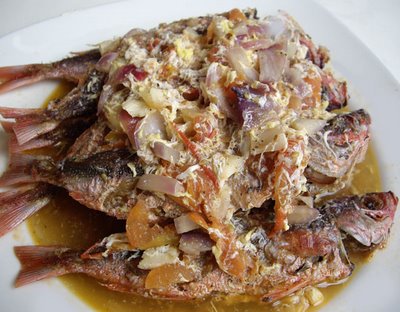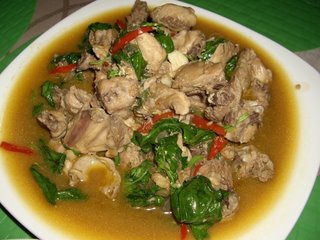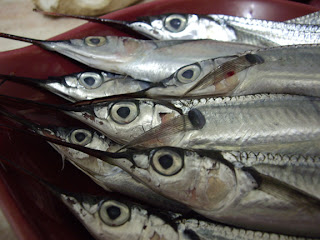 Another find we had at South Supermarket is the River Cobbler, in fillets. River Cobbler is the commercial name given to Tra, a variety of Vietnamese catfish (the other being Basa). In the US, River Cobbler is marketed as China Sole. (Info source: here and here.)
Another find we had at South Supermarket is the River Cobbler, in fillets. River Cobbler is the commercial name given to Tra, a variety of Vietnamese catfish (the other being Basa). In the US, River Cobbler is marketed as China Sole. (Info source: here and here.)Anyway, River Cobbler, despite being catfish, tastes nothing like our local catfish hito. It has a delicate texture and nice, white flesh. Judging by the taste, size and appearance, I think it's the same fish used by Fish and Co. for their fish and chips. If you've had that, you know the flesh is juicy and tasty, the stuff fish-lover dreams are made of. :)
This River Cobbler though wasn't deep-fried but turbo-broiled wrapped in aluminum foil. The cajun seasoning gives the broil an interesting kick -- not really spicy but not actually tame, and the mix of herbs and spices (cayenne pepper, black pepper, onion powder, garlic powder, chili powder, thyme, sweet basil and bay leaf) just adds dimensions of taste and aroma to the dish. I think this makes a nice Friday night dish, a great way to end the monotony of the usual dishes of the week.
There are many commercially available cajun seasonings, like McCormick Cajun Seasoning which I used here, but you can also make the seasoning from scratch (recipe here).
CAJUN RIVER COBBLER
What's In It?
1 pack River Cobbler Fillets (about 500g.), thawed
1 1/2 teaspoon salt
1 pack McCormick Cajun Seasoning
Kitchen Conjugations:
Wash the fish fillets and drain over wire racks. Combine salt with cajun seasoning, then rub over both sides of the fillets. Wrap fillets in aluminum foil, leaving some air pockets between the top side of the fillets and the foil (to allow steam to circulate and prevent burning/drying).
Carefully place over wire racks in the turbo broiler and broil for 15 minutes at 180 to 200C.
Serve with blanched/buttered vegetables.
PS: If you're partial to frying, you can opt to cut the fillets lengthwise into halves, dip them in eggwash (1 beaten egg + 3 tablespoons water) then deep fry for 3 minutes or until golden. Drain excess oil from the fillets then coat with the cajun seasoning.













 Mike and I, we love seafood. As you (would) probably notice, most of the recipes (and food reviews) here (will) feature prawns, squid and fish.
Mike and I, we love seafood. As you (would) probably notice, most of the recipes (and food reviews) here (will) feature prawns, squid and fish.





























